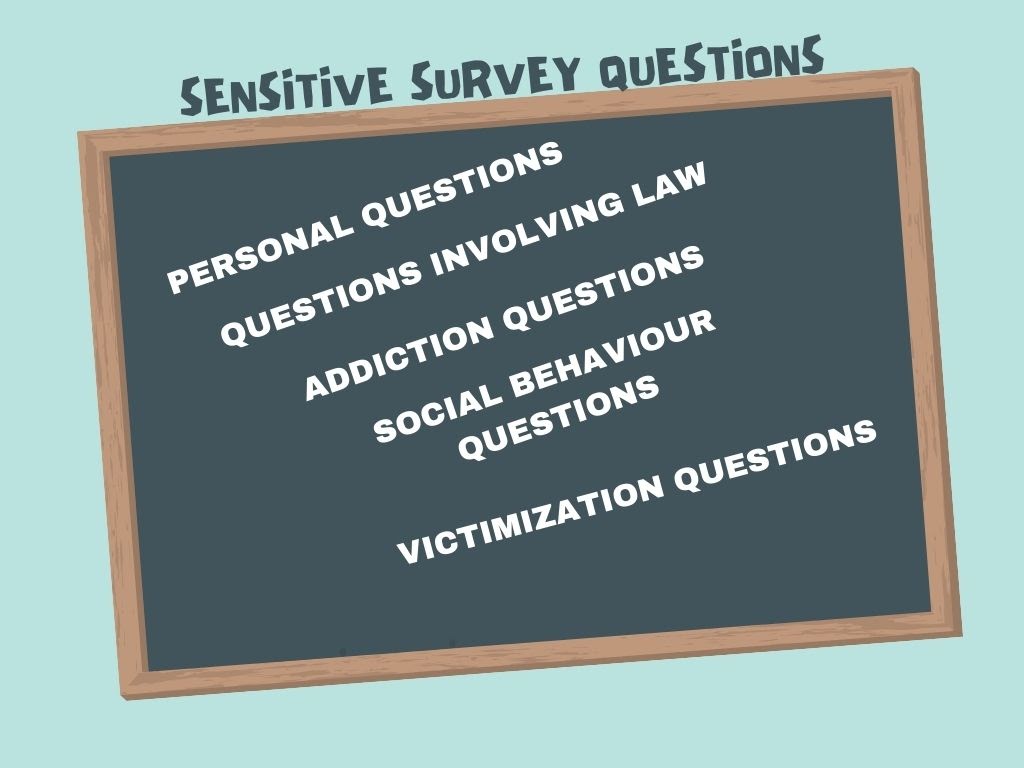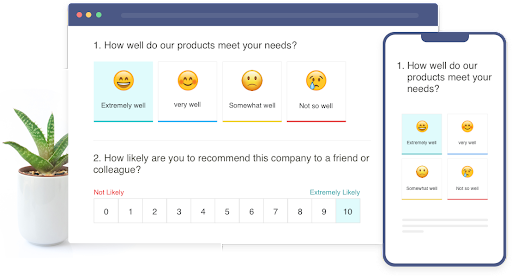
A survey is an effective medium to collect feedback from your target audience. Sensitive questions on age, income, race, and religion form an unavoidable part of demographic surveys, market research surveys, health surveys, and so on.
Usually, people are reluctant to share personal information via offline surveys. But, online surveys can be made more discreet and anonymous to put forth sensitive questions. This ensures that respondents don’t feel conscious or shy while taking the survey.
This blog tries to cover the concept of ‘How to ask sensitive questions in surveys, the right way.’
What is Considered a Sensitive Question?
Sensitive questions are those questions that make your survey respondents feel awkward or embarrassed while answering. Also, these questions tend to infringe on the privacy of your respondents. Usually, respondents choose not to give a straightforward answer to this question unless it is worded the right way.

Image Source: Canva
Sensitive questions in surveys fall in the category of:
- Personal survey questions on age, income, marital status, religious affiliation, race, gender.
- Sensitive questions on the addictions of a person like drinking, smoking, drug abuse.
- Questions that remind the person of victimization like domestic violence, sexual harassment, racial abuse, etc.
- Questions that ask for a socially desirable response like exercising, meditating, going to church regularly, etc.
- There are certain sensitive questions that try to gauge if a respondent was on the wrong side of the law, like breaking traffic rules, not paying taxes, etc.
With a clear understanding of sensitive questions examples, let’s understand the results of asking sensitive questions in the next section.
What Are the Consequences of Asking Sensitive Questions?
Sensitive questions in a survey can lead to skewed and incorrect responses from your target audience if not planned appropriately.
Here are some of the consequences of asking sensitive questions:
- Increased Survey Dropout Rates: Sensitive questions can irk your survey respondents and make them feel uncomfortable. They may prefer to exit your survey altogether. If the majority of your respondents leave your survey midway, it will make your survey process irrelevant.
- Inaccurate Responses: There are chances that your survey respondents will give a false answer or socially desirable answer to go with the common opinion. These unreliable survey responses cannot help you to analyze the survey in detail.
- Blank Responses to Questions: Many survey respondents prefer to skip sensitive questions by leaving a blank field or selecting the option ‘Prefer not to answer.’
Despite the challenges involved in putting forth sensitive questions, sensitive survey questions are needed for many reasons. Let’s understand it in the next section:
What Is the Need for Asking Sensitive Questions in a Survey?
Sensitive questions help organizations, and the government better understand the needs and challenges of the target groups.
- Policymaking: With a clear understanding of vulnerable people, the government can bring in necessary policy changes to uplift their condition.
- Institutional Changes: Analysis of matters like domestic violence, racial abuse, mental abuse, etc., is needed to understand the institutional changes that can make the life of the victims better.
- Market Research: Sensitive demographic questions help organizations have clear personas of their existing and potential customers. For example, married customers have different needs as compared to single customers. With this information at hand, companies can create a customized experience for a diverse audience base.
With a clear understanding of the need to ask sensitive questions, let’s understand the difference between asking questions in an online survey and an in-person survey.
Sensitive Questions in Online Surveys vs. In-Person Surveys
Sensitive questions work differently on online and offline platforms. People are more comfortable answering sensitive questions on an online platform.
| Pros | Cons |
| Difficult to understand emotions and body language. It isn’t easy to persuade them to answer. | Easy to understand the body language of the respondents and persuade them to answer. |
| More privacy to answer. | Less privacy to answer. |
| Chances of a more honest answer due to less privacy concern. | Chances of a less honest answer due to more privacy concerns. |
Now, let’s explore some strategies on how to ask sensitive questions in a survey with ease.
How to Ask Sensitive Questions Like a Pro
Here are some smart ways to ask sensitive questions without making the respondents feel uncomfortable. Let’s dig in:
(a) Prefer Self-Administered Modes Like Online or Web Surveys

By asking sensitive questions in an online mode, you reduce the chances of respondent identity. When respondents are not face to face with the interviewer, they feel comfortable to answer behavioral and personal questions. Keep offline surveys as a last resort in case of power outages, low internet connectivity, etc.
(b) Ensure Confidentiality of Survey Data
Assure your survey respondents that their data will remain confidential, and their responses will be anonymous. This gives your respondents the motivation to open up and give frank responses to sensitive questions.
Phrase the privacy clause persuasively to build up the confidence of your survey respondents like: “Your responses will remain confidential, and your private details will not be shared with anyone.”
(c) Explain the Purpose of Asking the Question
Explain the reason for the whole survey exercise. You can assure your respondents that the survey is conducted as a group exercise for better research and policymaking purposes. When respondents feel that their responses will be used for a constructive and positive purpose, they will be more inclined to give feedback.
(d) Ask Demographic Questions Towards the End of the Survey

Image Source: CartoonStock Ltd
Always start with icebreaker questions to make the participants feel comfortable. You can begin by asking about their interests and hobbies. Once you have built a strong rapport with them, ask the demographic questions towards the end of the survey. Participants will be more comfortable to answer questions on location, age group, marital status, etc., at a later stage.
(e) Position-Sensitive Questions towards the End (but not the very End)
Attempting a sensitive question right from the beginning of a survey can give nightmares to your survey respondent. They may feel uncomfortable to continue through the survey process and ultimately drop out of the survey.
Hence, position your survey questions somewhere at the end, but not the extreme end. There are chances of survey fatigue even at the extreme end wherein respondents may not give a well thought out reply.
(f) Include Range Response as Opposed to a Numeric Response
Asking respondents to answer in a range format does not look intruding. The respondents feel that they are not directly giving out their exact information.
Let’s take an example,
- In which age group do you fall?
- 11-20 years
- 21-30 years
- 31-45 years
- 45+
Herein, respondents are more comfortable answering “21 – 30 years” rather than just “30 years”.
Further, you can use branching questions to filter out the desired range and ask different follow-up questions for your wide audience base. This ensures that you get detailed and subjective feedback from each respondent.
(g) Use “Question Loading” Strategies
Question loading strategy helps you put an empathetic foot forward while asking your respondents a sensitive question. Using this strategy, you make them feel comfortable while answering the questions.
Let’s consider some sensitive survey questions examples,
- We know that it is challenging to find time for exercising amid hectic work. It happens with all of us. How often do you exercise?
- We all love to keep our surroundings clean, don’t we? But, sometimes, we all lose out on waste segregation. Do you segregate waste regularly?
In the above questions, we try to reassure the respondents that a behavior pattern is familiar before asking them a sensitive question. When respondents feel that the behavior pattern is not unique, they do not feel singled out. They feel more comfortable in answering the questions.
(h) Prefer a Direct Frequency Question Rather than Using a Yes/No Filter.
If you want to know the frequency of repeating a behavior by your respondents, do not ask them directly. It may sound rude and intimidating. Instead, indicate a range that sounds less intruding and generalistic.
For example, consider this question.
How many times a day do you exercise?
- 3-5 times a week
- 0-2 times a week
- More than 5 times a week
(i) Skew Response Scale in the Opposite Direction of the Bias
Herein, you can vary the answer options following the response bias of your respondents. Place the socially desirable options at the beginning and push the undesirable options to the End. It ensures that you get a high survey response rate.
(j) Make Use of an Indirect Approach Like Item Count Technique
This is an exciting surveying technique wherein you ask the respondents to select a few items that apply to them from a list. The list could involve your target item list, based on which you want to survey people. In this way, you are indirectly getting their answer to a sensitive question.
For example, consider the question:
- Which of the following have you tried out once in your lifetime?
- Road trip
- Mountaineering
- Using drugs
- Smoking
- Going on a solo trip
Herein, you want to know if the respondent has taken drugs or smoked. You are giving them an option to choose from a list of other desirable hobbies as well. The respondent may find it non-intrusive and provide an honest answer.
Make Your Sensitive Survey Questions Sensible and Empathetic
Sensitive survey questions are unavoidable when it comes to situations of greater good like effective policy making, understanding the needs and challenges of abuse victims, reinforcing social behaviors, etc. With careful phrasing and planning, sensitive questions will no longer be intrusive and judgemental.
Use various techniques like question loading, item count technique, and skewed response scale for strategizing sensitive questions in your surveys. These techniques ensure that your survey respondents do not drop out midway through and also give honest responses.
Wondering how to send your first survey with sensitive questions? You can try our ProProfs Survey Maker with custom survey templates ranging from a demographic survey to a market research survey.
FREE. All Features. FOREVER!
Try our Forever FREE account with all premium features!







